Scott Mautz is a leadership expert, bestselling author, and the CEO of Profound Performance™, a company that helps leaders and organizations unlock their potential through mental strength and performance coaching. He previously held senior executive roles at Procter & Gamble. Mautz has dedicated over 30 years to studying leadership and personal development. He now offers unique insights on how mental strength is the defining trait of highly effective leaders.
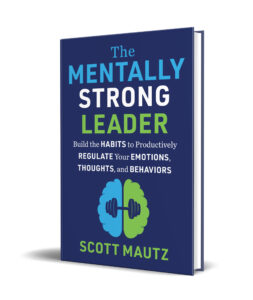 Today, we are sharing an insightful interview with Mautz.
Today, we are sharing an insightful interview with Mautz.
He discusses key takeaways from his latest book, The Mentally Strong Leader. This interview will walk you through his actionable framework for building mental fortitude, goal focus, and decision-making muscles—all essential traits for thriving in leadership roles. One of the more surprising revelations he shares is that confidence isn’t about eliminating doubt but learning to manage it.
In the interview below, Mautz unpacks these concepts and provides tools to help leaders handle adversity, regulate their emotions, and stay goal-oriented. Enjoy the full interview and discover how mental strength could be the superpower that changes your leadership approach.
Scott, can you share what personal experiences led you to explore and write about mental strength in leadership?
I spent three decades in corporate America, all while studying what discerned great leaders from those who merely held leadership positions. A study I repeatedly conduct summarizes the experiences I’ve had that drove me to write about this topic. I ask 3,000 executives at a time, “Thinking of the highest-achieving organizations you’ve ever been part of, that overcame the most obstacles, what attributes/behaviors did the key leader embody?” Consistently, 90 percent describe a mentally strong leader.
How do you define mental strength, and why is it crucial for leaders today?
Mental strength is more than just EQ (EQ is, in fact, a slice of the broader umbrella of mental strength). Mental strength is the ability to productively regulate not only your emotions, but your thoughts and behaviors as well, even in adversity. In an increasingly volatile, exhausting world, with more and more distractions, fear, mistrust, and potential inducements of self-doubt, mental strength is THE skill required for leaders to excel in the next decade. It’s a cheat code for achievement – the leadership superpower of our times. It’s the “next EQ” in terms of importance, especially since it’s an empowering level above EQ.
What are the six mental muscles you discuss in your book, and how do they contribute to effective leadership?
The six mental muscles that equate to mental strength are Fortitude, Confidence, Boldness, Decision-Making, Goal-Focus, and Messaging (staying positive-minded in the face of negativity and having an engaged presence). They all require self-regulation, and my research shows they embody the skills that most directly correlate with achievement – especially in adversity.
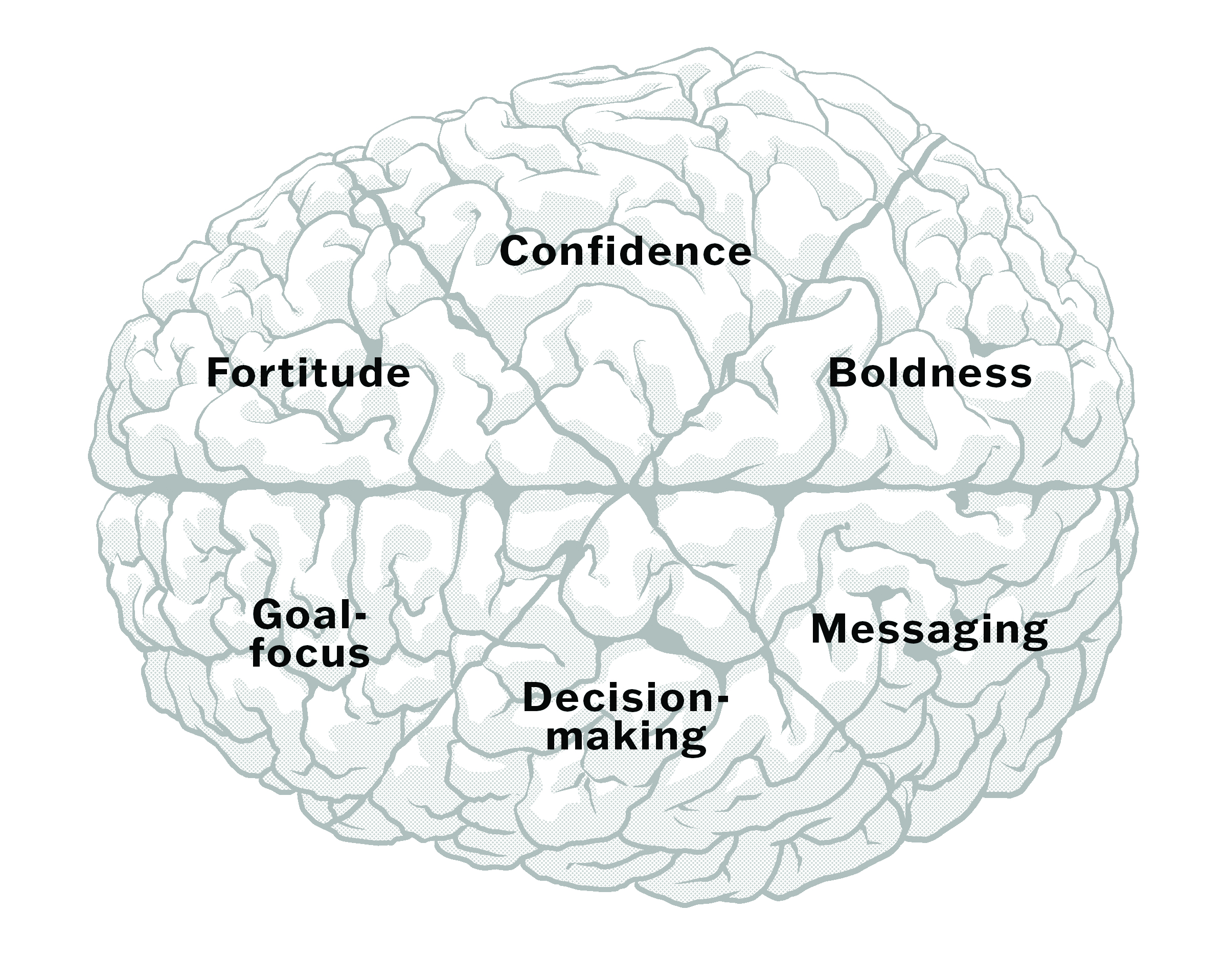
Do you have to work on all the mental muscles? How do you know which to work on?
In The Mentally Strong Leader, you can take a Mental Strength Self-Assessment. It consists of 50 questions, taking about 15 minutes to complete. You get an overall Mental Strength Score – a baseline of how mentally strong you are. You also get a score for each of the 6 mental muscles, so you know which mental muscles to maintain and which to “level up.” It helps you create your own, customized mental strength training program. And note, you don’t have to work all the muscles, all the time. After all, if you went to the gym, you wouldn’t work every muscle in your body, every time. You’d have a regimen.
Can you explain the concept of “grindfulness” and how it differs from traditional mindfulness practices?
Grindfulness is a combination of gratitude and mindfulness.
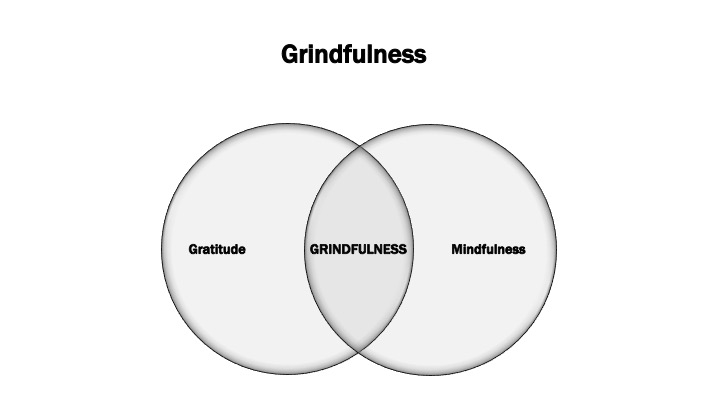
It’s being present in daily life, noticing details in the grind of it all, and expressing appreciation and joy for those details in the moment. For example, say you’ve been laid off from your job, and have been interviewing almost every day, for a while now. It’s wearing you down, affecting your mood and disposition, magnified by the “no’s” you’re getting. In the midst of it all, you recognize how much you love and appreciate the quiet, reflective morning breakfasts you’re able to have each day. That little spark tunes you in to more small things to appreciate about your current situation, helping your disposition. That’s grindfulness. It’s being mindful to notice and appreciate positive aspects of the details of whatever grind you find yourself in. It’s not about passively journaling those moments (a typical mindfulness practice), it’s about actively living those moments and building a daily habit of doing so.
And it’s the combination of gratitude and mindfulness that makes it so powerful. Sometimes, we struggle to express gratitude, especially as adversity wears on. We might be too restrictive of what deserves our gratitude, or our sense of gratefulness gets overpowered by all the irritations and disappointments we encounter. Likewise, mindfulness (calmly focusing your awareness in the present moment) isn’t enough on its own either; you have to act on your observations or actively shift your perception in some way that improves your outlook. Enter grindfulness, which lowers the bar on what to be grateful for and mindful of, and raises the frequency of expressing appreciation and joy in those “moments of grind,” all to improve your temperament.
What is an Adversity Manifesto? How can leaders create one, and what benefits does it bring?
It’s a simple, one-page document you give to your organization before adversity strikes. It outlines what you expect from the team when adversity arises, and what they can expect from you. Think of it as a code of conduct for when storms hit, or as a fortitude “cheat code.” Here’s an example of one such manifesto I used for many years, to great effect:

To create one, think of the most important things you want your organization to do when adversity strikes, and write them down. Sharing an Adversity Manifesto announces several things to the organization: a) there will be adversity in the future – expect it. It’s life in the working world, b) this is how to act when the going gets tough. Expect me to model it. Hold me to it, and c) I expect the same behaviors from you. Clarifying all this increases an organization’s fortitude and ability to successfully work through setbacks.
How can leaders apply the principles of mental strength in their daily decision-making and goal setting?
In The Mentally Strong Leader, I share many tools to help leaders strengthen their decision-making and goal-focus mental muscles. On the decision-making front, for example, leaders must be self-aware of and manage decision making biases that distort their ability to make good decisions. They must learn to stop bad habits that lead to bad decisions, hold disciplined decision-making meetings, know when to decide and when not to, collect data wisely and analyze it critically, and default to being decisive. To stay goal-focused, they must set intrinsically motivating goals, set expectations – thoroughly, avoid distractions with intention, and sharpen their focusing skills.
You mention the importance of regulating emotions, thoughts, and behaviors. Managing your negative emotions in the moment can be really hard. Can you share some practical strategies for leaders to achieve this?
To overcome negative emotions in the moment, use The Redirect Rhythm.
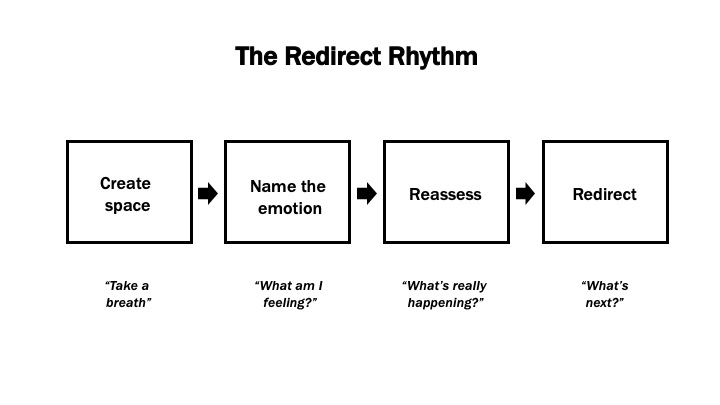
There are four simple steps, and an accompanying “trigger phrase” to use along the way. Follow the steps and trigger phrases when your emotions start taking over. The steps are meant to happen progressively, and quickly.
Step 1: Create space. First create some distance from the intensity of the emotion. It’s about breaking the gravitational pull of the emotion that’s dragging you somewhere you don’t want to be. Detach and say to yourself the first trigger phrase, “Take a breath.” That’s it. Stop. Pause. Breathe. Take a few beats to collect yourself.
Step 2: Name the emotion. Naming the emotion is a clever way to force you to become aware of your emotions. To trigger this, you ask, “What am I feeling?” This serves as a fill-in-the-blank prompt, of sorts. Putting it in the form of a question demands an answer, (“I’m feeling ______.”) Once you name the emotion, it begins to lose its hold over you.
Step 3: Reassess. This is where the great equalizer enters – logic. Emotions can cloud logic and reason, creating alternate truths. But logically reassessing the situation forces you to challenge the story you’re telling yourself, reframing it in a way that defuses its emotional impact. The effectiveness of this is broadly supported in research, and is known as cognitive reappraisal. You trigger a reappraisal by asking, “What’s really happening?” It forces a realistic assessment of the situation rather than an exaggerated distortion. This forces you to focus on the underlying thoughts you’re having rather than the emotion you’re feeling. In other words, this is where you (rationally) think, before you act.
Step 4: Redirect. Something isn’t working, so it’s time for a new tact, to engage in a more productive behavior. You trigger that by simply asking, “What’s next?” What can you do now that would produce a more beneficial outcome?
In your research, what common challenges do leaders face in maintaining mental strength, and how can they overcome them?
Most often, a leaders’ mental strength can break down in moments of weakness. For example, your confidence muscle feels big and bulging, until that bad meeting with your boss that you felt like you really screwed up. Just like that, your confidence takes a major hit. If you want to maintain the habits that help you stay mentally strong, it’s critical to know what to do in moments of weakness. That’s why each of the 50+ proven tools in The Mentally Strong Leader include a section titled “In Moments of Weakness” to help you maintain a specific habit and stay mentally strong.
What advice would you give to leaders who struggle with imposter syndrome and self-doubt?
Overcoming self-doubt starts by understanding that confidence is not the absence of doubt. It’s the ability to manage your relationship with doubt – because it’s present in all of us to some degree. I interviewed thousands for The Mentally Strong Leader and I can tell you that not even the most confident people would say that there is a complete absence of doubt for them. You maintain a healthy relationship with doubt by regularly conducting doubt assessments – that is, by evaluating where you are on the Doubt Continuum.
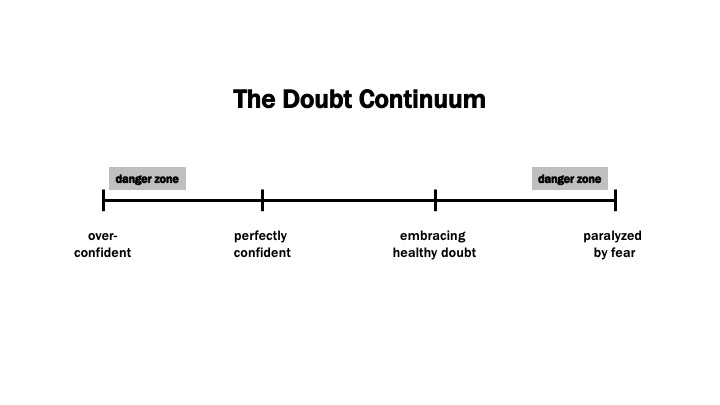
The idea is to avoid the two danger zones on the ends, where you’re either overconfident or paralyzed by fear. You want to fall in the center, either perfectly confident (balancing intuition, data, experience, practice, and skill with devil’s advocates/outside opinions that keep you honest) or embracing healthy doubt (being okay with not knowing everything and believing in your ability to figure things out along the way). The point is to regularly conduct self-doubt assessments, stopping to ask yourself, “Where do I fall on the Continuum right now?” It’s this understanding that you must manage your relationship with doubt on an ongoing basis that’s so powerful.
Regarding overcoming imposter syndrome, a few things to keep in mind.
a) Own your accomplishments.
Instead of feeling unworthy of where you’re at, undeserving of praise or attention, ask yourself these questions:
- Where am I underestimating and underappreciating myself?
- What should I give myself more credit for?
- Where am I assigning too much credit to luck, or other external factors?
- What simply would not have happened, were it not for me?
For some, focusing on your accomplishments will still produce a “Yeah but…” reaction. You might still focus on all the ways you’re inadequate. Enter the next strategy.
b) Be open to imposter discomfort, closed to imposter thoughts.
Clinical psychologist Jill Stoddard stresses the importance of being able to sit with discomfort, to move forward with your life plan despite the nagging feelings of imposter syndrome. It’s known simply as “acceptance” in psychology circles. As Stoddard says, “When you’re willing to allow discomfort, you greatly broaden your options for choosing behaviors.” In other words, yes, you might have doubts about whether or not you can really lead the team in your new role. But learning to be okay with it, to let that sit in the background, allows you to focus on deciding how to do it best, not if you can do it.
At the same time, try detaching yourself from your imposter thoughts. When they pop up, imagine them inside a cartoon bubble, floating above your head, completely detached from you. You know these thoughts aren’t trying to help you move toward the life you want to live, so why listen?
c) Think of your value(s) rather your valuation.
Yes, I’m referring here to both your value and your values. First, focus on the unique value you bring to the table, not your “valuation,” what others might think you do, or don’t, deserve. What skills, strengths, and perspective do you undeniably offer?
And, think of your values, too – what you stand for, what represents your primary way of being. When imposter feelings make you cast doubt on yourself, keeping you from embracing the life you want to live, booing you from the cheap seats, your values are cheering you on from the front row. They’re your reminder that what you’re doing matters, that it supports what you stand for, no matter what anyone thinks.
For more information, see The Mentally Strong Leader.


